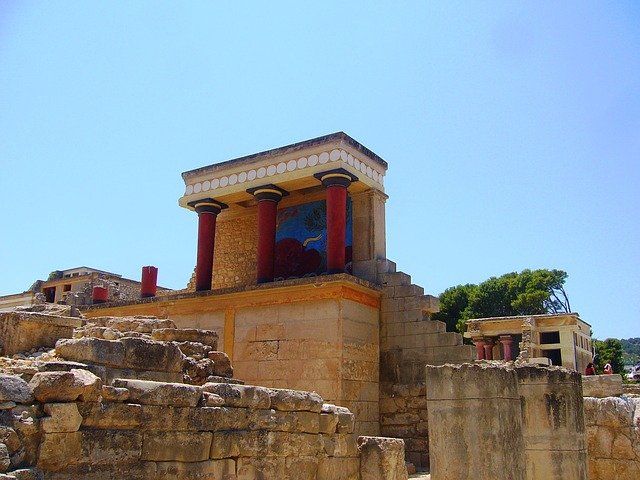By Tim Lambert
The Minoan civilization existed in Crete. It was the first European civilization. About 2,500 BC a sophisticated society grew up on the island of Crete. By about 1,950 BC the inhabitants had invented a form of writing using hieroglyphs. This writing is called linear A.
The Minoans were a bronze-age civilization. (They made tools and weapons from bronze). Their civilization was at its height from about 1700 BC to 1500 BC. However Minoan culture declined after 1450 BC. We are not sure why but they may have been conquered by people from mainland Greece.

After its fall the Minoan civilization was largely forgotten. However, its memory did linger on in Greek myths. In 1894 British archaeologist Sir Arthur Evans (1851-1941) visited Crete for the first time. Finally in 1900 began excavating the remains of a palace at Knossos. Eventually, the ruins of a great civilization were uncovered.
Most of the Minoans lived in small villages and made their living from farming. They grew wheat, barley, grapes, and olives. They raised goats, cattle, sheep, and pigs. Minoan farmers had to give part of their crops to the ruler as a tax.
In wall paintings, men and women are shown with long curly hair. Men wore loincloths. Men also wore a kind of kilt. Women wore layered skirts and bodices which exposed their breasts.
The Minoans were also trading people. They traded with Sicily, Cyprus, Egypt, and other parts of the Middle East. The Minoans exported wine, olive oil, timber, and pottery. (Minoan potters made very thin pottery called Kamares ware). They also exported jewelry and weapons. Merchants imported lead, copper, obsidian, and ivory.
The Minoans are famous for the palace at Knossos (although there were other palaces at Mallia, Zakro, and Phaistos). The palace at Knossos was built around a central courtyard. On the ground floor of the palace were storage areas. In them, grain and olive oil were stored in large clay jars called pithoi. Also at ground level were workshops for specialist craftsmen. Many scribes in the palace kept careful records of the stores.
The upper floors of the palace were living quarters and they were luxurious. Light wells let in both light and cool air. Wooden columns painted red supported ceilings. Frescoes were painted on the walls. Sometimes human beings were painted but often sea animals such as dolphins were shown. (The Minoans also painted pottery vessels with sea creatures like octopuses, fish, and sea urchins showing the importance of marine life). Some rooms in the palace of Knossos were lined with alabaster. The palace at Knossos had bathrooms and even a flushing toilet.
Each Minoan palace was surrounded by a large, unfortified town. The fact that the towns were unfortified showed that life in ancient Crete was peaceful. Perhaps the fact that the Minoans had a large and powerful fleet made them secure.
Little is known about the Minoan religion but bulls seem to have been important. perhaps they were sacrificial animals. Minoan frescoes also show a game where men and women grabbed a bull’s horns and then somersaulted onto its back. It is unclear whether this was just a game or part of a religious festival.
Minoan craftsmen also made ceramic models of women holding writhing snakes in their hands. It is believed these statues represent goddesses.
Last revised 2025